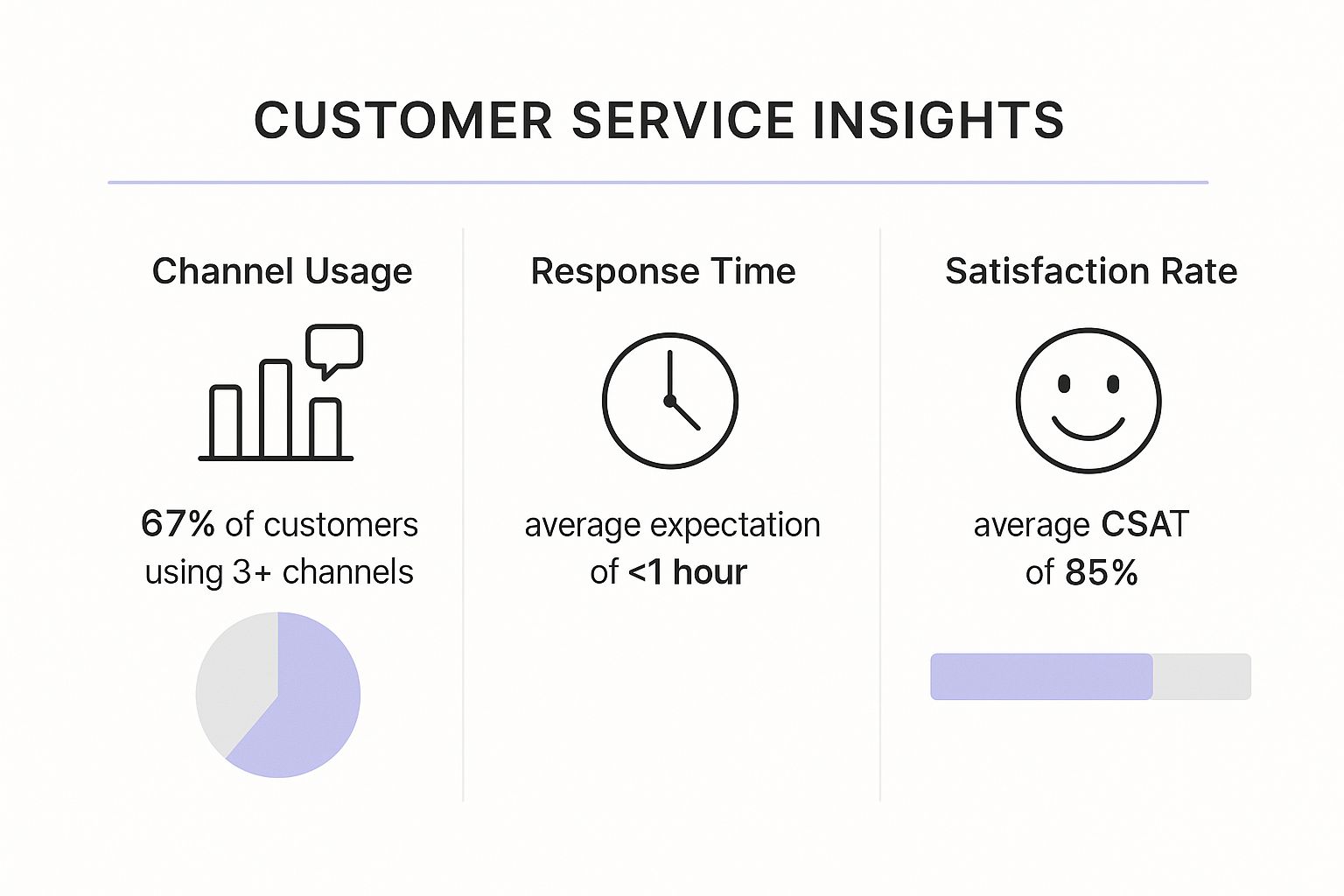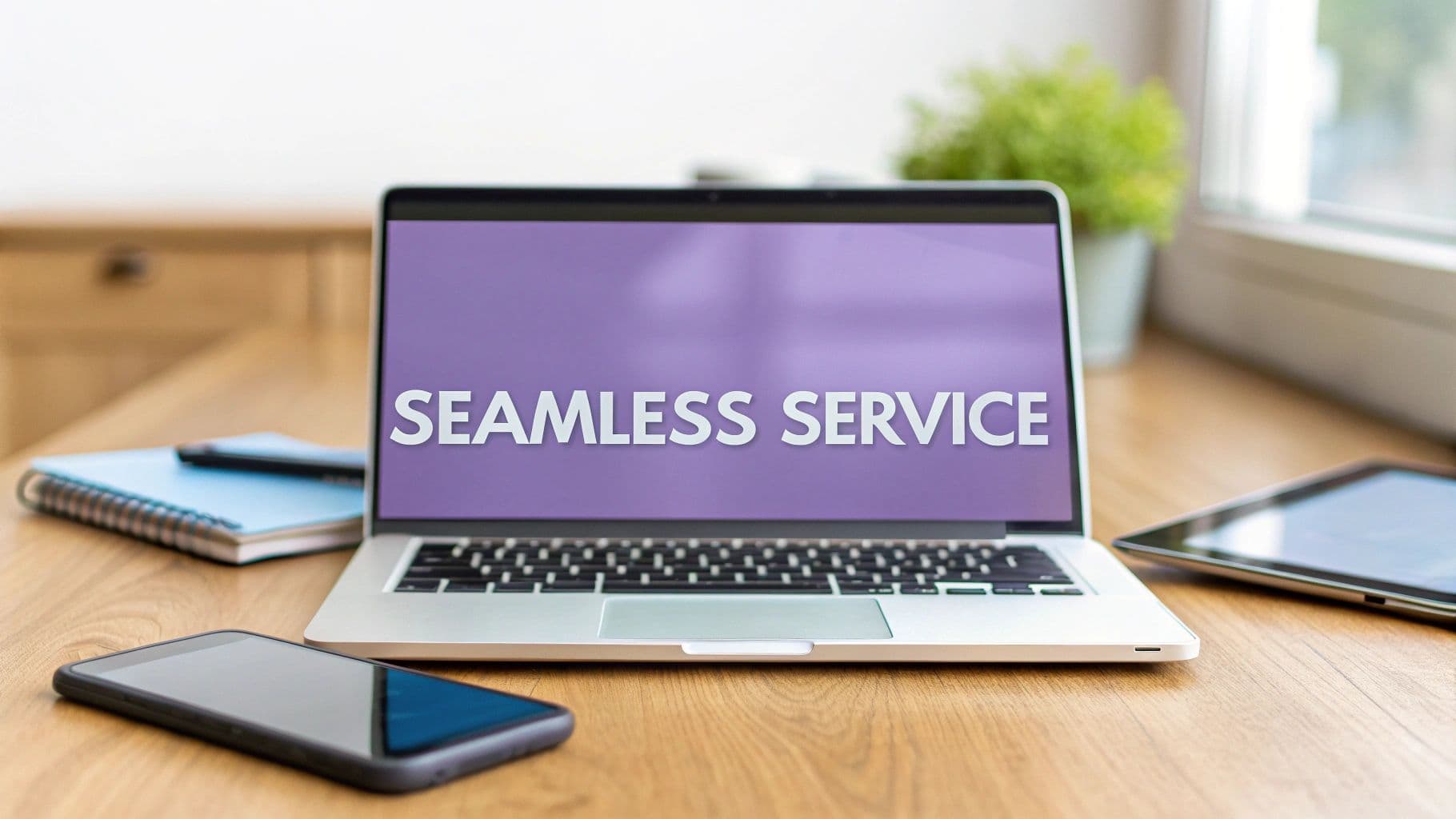Beyond Multiple Channels: The True Power of Omnichannel Service

Many businesses believe they're offering omnichannel customer service. However, they often provide multichannel support instead. This means they're on various platforms, but those platforms aren't connected. This creates a disjointed and frustrating customer experience. True omnichannel service, powered by customer interaction analytics, unifies these channels. Customers can move between them seamlessly, retaining their context and history.
Think of it this way: multichannel support offers several separate, single-lane roads. Omnichannel service, on the other hand, is a superhighway connecting everything. This key difference is crucial for meeting today's customer expectations and driving business success. Learn more about an omnichannel communication strategy.
Understanding the Omnichannel Advantage
Effective omnichannel strategies do more than improve customer satisfaction; they impact key business metrics. Companies with strong omnichannel experiences see a 10% year-over-year revenue growth and 25% higher close rates. This makes sense, as 71% of customers expect consistent service across all channels.
However, there's a gap between expectation and reality. Only 29% of customers feel brands truly deliver this consistency. This highlights the urgent need for real omnichannel integration. Find more detailed statistics here.
The Customer-Centric Approach of Omnichannel
Omnichannel service represents a shift toward a customer-centric approach, not just a technology upgrade. It recognizes that customers interact with brands in various ways, empowering them to choose their preferred channels. This flexibility is key, especially since 65% of global customers now demand personalized, adaptive service.
For example, a customer might start researching a product on social media, then switch to a website's live chat for questions, and finally buy the product in-store. Omnichannel ensures a connected experience throughout this journey.
To further illustrate the differences between omnichannel and multichannel approaches, let's look at a comparison table. This table highlights key features and how each approach handles them, offering insights into why true integration is important.
| Feature | Omnichannel Approach | Multichannel Approach |
|---|---|---|
| Channel Integration | Seamless, unified experience across all channels | Separate, disconnected channels |
| Customer Data | Centralized and accessible across channels | Siloed within each channel |
| Customer Journey | Continuous and consistent across all touchpoints | Fragmented and disjointed |
| Communication | Personalized and contextualized based on customer history | Generic and often repetitive |
| Support Agents | Equipped with complete customer information | Limited visibility into customer interactions |
As you can see, the omnichannel approach focuses on a unified and personalized experience, while the multichannel approach often leads to a fragmented and impersonal customer journey.
Visualizing Omnichannel Impact
The data chart below visualizes the difference in key performance indicators between companies using successful omnichannel strategies and those with less integrated multichannel approaches.

The data chart clearly shows omnichannel leaders outperforming their multichannel counterparts across all metrics. The higher revenue growth, close rates, and customer retention demonstrate the positive impact of connected customer experiences. The significant difference in customer satisfaction scores emphasizes the importance of seamless, consistent service across all touchpoints.
IKEA exemplifies successful omnichannel strategies. Its integrated app, delivery network, and in-store experience drive substantial revenue (over $40 billion annually) while maintaining consistent service.
This customer-centric approach is a business imperative. PwC reports omnichannel adoption has jumped from 20% to over 80% recently. Businesses recognize its crucial role in building customer loyalty and driving revenue. The key is not just being on multiple channels but orchestrating them into a cohesive, customer-focused system.
Building the Foundation: Essential Elements of Omnichannel Success

Effective omnichannel customer service isn't simply about being on multiple channels. It's about crafting a unified and seamless experience. This requires a strong foundation built on interconnected systems, data-driven insights, and a customer-focused approach. Without these core elements, even the best efforts can lead to fragmented, frustrating customer experiences.
The 360-Degree Customer View: Unifying Your Data
A key part of successful omnichannel service is the 360-degree customer view. This comprehensive view provides a unified snapshot of each customer's interactions, preferences, and history across all channels.
This single source of truth empowers agents to deliver personalized and efficient support. Customers won't need to repeat information, leading to greater satisfaction. Imagine a customer starting a conversation via live chat on your website, then following up via email. With a 360-degree view, the agent handling the email has access to the full history, creating a consistent experience.
Breaking Down Silos: Integrating Your Systems
Data silos are a major obstacle to true omnichannel service. Different departments and systems often operate independently, hindering information flow. Integrating these systems, from CRM platforms to order management tools, is crucial for a unified customer experience.
For example, integrating your CRM with your live chat platform lets agents instantly access customer details and purchase history during a chat. This enables faster resolutions and personalized recommendations.
Empowering Your Team: The Human Element
While technology is essential, human skills and organizational structure remain critical. Teams need training to use omnichannel tools effectively and embrace a customer-centric approach.
Clear roles, workflows, and communication protocols ensure everyone is working towards a common goal: seamless customer service. Research shows customers value highly responsive support across channels, making team enablement a top priority. This involves investing in training that focuses on empathy, active listening, and problem-solving across diverse communication methods. Internal feedback and knowledge sharing also help teams continuously improve.
Governance and Continuous Improvement: Maintaining Consistency
Finally, governance and continuous improvement are key for long-term success. Regular audits, performance monitoring, and customer feedback analysis help pinpoint areas for optimization.
This iterative process ensures your omnichannel strategy stays aligned with customer needs and evolving technology. Analyzing interaction data and customer feedback allows you to refine workflows, personalize messaging, and proactively address potential pain points. This data-driven approach is crucial for achieving and maintaining omnichannel excellence.
Delivering What Customers Actually Want Across Every Channel

Today's customers expect a seamless experience across all channels. This means businesses need to understand not just where their customers are, but what they want on each platform. Failing to meet these rising expectations can result in lost customers and missed opportunities. This discussion explores how delivering true omnichannel customer service addresses those expectations by focusing on speed, personalization, and consistency.
Speed and Channel Diversity: The New Standard
Customers today are naturally omnichannel. They move between their phones, laptops, and tablets seamlessly and expect businesses to keep pace. This requires fast response times and the ability to interact with customers on their preferred channels.
For example, a customer might begin by browsing products on a company website, then ask questions through social media, and finally make a purchase via a mobile app. Each interaction should feel connected and efficient. This demand for quick, personalized service across multiple platforms presents a key challenge for businesses: maintaining consistent service quality at speed.
This expectation for speed is supported by data: 54% of consumers prefer brands that respond quickly. On social media platforms like Twitter and Facebook, this is even more critical, with 50% of Twitter users and 47% of Facebook users expecting replies within three hours. For more statistics on omnichannel customer service, see Discover more insights about omnichannel statistics.
Balancing Automation and Human Touch
The need for efficiency has led to the increasing use of AI-powered tools in customer service. However, finding the right balance between automation and human interaction is essential. While Gartner predicts 85% of customer interactions will be automated by 2025, the human touch remains vital.
This human element is especially important for complex issues where empathy and personalized solutions are key. A chatbot can handle routine requests like order tracking, for instance. But for more complicated problems, a seamless transition to a human agent with access to the entire conversation history ensures a smoother, more positive customer experience. This is where FlowGent AI stands out, by allowing businesses to use intelligent AI agents that integrate smoothly with human teams.
Personalization Without the Premium
Personalized service shouldn't require a huge investment in technology. Practical steps include segmenting customers based on their behavior and preferences, then tailoring messaging and support accordingly. This could be as simple as customizing email content based on previous purchases or offering proactive support to customers who recently encountered an issue.
Brand Voice Across Every Touchpoint
Maintaining a consistent brand voice across all channels is crucial. While communication styles may vary depending on the platform (a more formal tone on email compared to a casual style on social media), the core brand identity should remain recognizable. This builds trust and strengthens customer relationships. FlowGent AI allows businesses to customize their AI agent profiles, ensuring each interaction reflects their unique brand voice, regardless of the channel. This consistency promotes customer recognition and reinforces brand identity across every interaction.
Technology That Enables Rather Than Complicates Service
Delivering exceptional omnichannel customer service hinges on the right technology. Instead of getting caught up in the hype, let's explore platforms that truly improve customer service operations, without adding unnecessary complexity and cost.
The Power of Integration and a Unified View
Connecting disparate systems is a major challenge in omnichannel service. Integrating older platforms with modern channels can be a complex project. However, smart integration approaches exist to simplify this process and enable a seamless flow of information.
These approaches focus on creating a unified customer view. They bring together data from various sources into a single, easily accessible location. This gives agents the context they need to personalize interactions and provide efficient support, no matter which channel the customer uses.
For example, imagine a customer contacts you through social media about an order issue. A well-integrated system allows the agent to instantly see the customer's purchase history, past interactions, and preferred communication methods. This empowers them to resolve the issue quickly and personally. FlowGent AI excels at integrating various customer service channels like social media, website chat, and email, ensuring customer context is maintained across every touchpoint. This allows agents to access a wealth of customer data and provide truly personalized support.
AI and Machine Learning: Practical Applications
Artificial Intelligence (AI) and machine learning offer practical solutions to current customer service challenges. These technologies are used to anticipate customer needs, intelligently route inquiries, and deliver personalization at scale. The result? Quicker response times, more streamlined workflows, and increased customer satisfaction.
Take AI-powered chatbots, for example. They can handle routine questions, freeing up human agents to address more complex issues. AI can also analyze customer data to predict potential problems or identify upselling and cross-selling opportunities.
FlowGent AI's no-code platform makes it easy for businesses to implement AI agents across various channels. These agents can handle routine inquiries, schedule meetings, and escalate complex issues to human agents, all while preserving context. This automation boosts efficiency and ensures consistent, high-quality support 24/7.
Cloud-Based Solutions: Accessibility for All
Cloud-based solutions are changing the game by providing access to sophisticated capabilities without large upfront investments. This is especially helpful for mid-sized companies that might not have the resources for extensive on-premise infrastructure.
This increased access means businesses of all sizes can utilize advanced features like real-time analytics and integrated communication platforms. These solutions offer scalability and flexibility, allowing businesses to adapt to evolving customer needs and market conditions. A phased approach to implementing cloud-based solutions minimizes disruptions and allows for gradual integration with existing workflows.
To better understand the key technologies driving effective omnichannel customer service, let's explore the following table:
Key Technologies Powering Omnichannel Customer Service: This table presents the essential technological tools and platforms that enable effective omnichannel customer service, including their primary functions and benefits.
| Technology Type | Core Functionality | Business Impact | Implementation Considerations |
|---|---|---|---|
| AI-Powered Chatbots | Automate routine inquiries, gather information | Improved response times, reduced agent workload | Training data quality, integration with existing systems |
| CRM Integration | Centralized customer data, interaction history | Personalized service, improved agent efficiency | Data migration, system compatibility |
| Cloud-Based Platforms | Scalable solutions, accessible features | Cost-effective, flexible, improved agility | Data security, vendor selection |
| Analytics Dashboards | Real-time performance monitoring, customer insights | Data-driven decisions, continuous improvement | Defining key metrics, data interpretation |
This table highlights the importance of integrated technologies working together to streamline operations and improve the customer experience.
FlowGent AI's platform embodies this flexible, scalable approach. With support for over 95 languages and automatic language detection, businesses can expand globally without the expense of hiring multilingual staff. Customizable agent profiles and multi-step workflow builders ensure the AI assistants reflect your brand and operational needs.
By focusing on the right technologies and implementation strategies, companies can build a powerful and efficient omnichannel customer service system. This approach leads to exceptional customer experiences, which in turn builds loyalty and drives growth. Effective data management, especially regarding security and accessibility, is critical for success in the increasingly complex world of customer service.
Measuring What Matters: Beyond Traditional Service Metrics

Traditional customer service metrics, such as average handling time and first contact resolution rate, often miss the mark when evaluating omnichannel customer service. These metrics tend to concentrate on individual channel performance. This narrow focus fails to grasp the interconnected nature of a true omnichannel experience. A new measurement approach is needed, one that reflects the customer journey across all touchpoints.
Key Performance Indicators for Omnichannel Success
To effectively gauge omnichannel success, businesses must shift their focus to cross-channel KPIs. These metrics offer a comprehensive view of the customer experience. They offer valuable insights into overall efficiency and customer satisfaction.
Some key omnichannel KPIs include:
For a deeper dive into key performance indicators for customer service, check out our guide.
-
Customer Effort Score (CES): This measures the ease with which a customer resolves their issue across all channels. A low CES indicates a smooth, frictionless experience. Conversely, a high CES highlights areas needing improvement.
-
Channel Attribution: Understanding customer channel preferences for different interactions is key. This allows for better resource allocation and optimized channel strategies. For example, AI-powered chatbots might handle simple inquiries on your website or social media. More complex issues may require human agents via phone or email.
-
Cross-Channel Resolution Time: This metric tracks the total time to resolve an issue, irrespective of the number of channels involved. This is crucial for measuring efficiency in complex cases where customers may switch between email, chat, and phone. It also helps increase customer lifetime value.
-
Context Loss Rate: This measures how often customers repeat information when switching channels. A high context loss rate signifies a breakdown in omnichannel integration. This can negatively impact customer satisfaction. FlowGent AI helps minimize context loss. It provides agents with a complete customer history, regardless of the channel used. This ensures a seamless and personalized experience.
Implementing Consistent Satisfaction Measurement
Consistently measuring customer satisfaction across all channels is crucial for evaluating overall omnichannel effectiveness. While traditional metrics like Net Promoter Score (NPS) can be helpful, modifications may be necessary.
For instance, a journey-based NPS considers the entire customer experience, not just individual interactions. This provides a more accurate representation of omnichannel success.
Operational Metrics to Identify Friction
Focusing solely on customer-facing metrics isn't enough. Analyzing operational metrics can reveal hidden friction points within the omnichannel system.
Two key metrics to consider are:
-
Cross-Channel Handoff Time: This measures the efficiency of interaction transfers between channels. Long handoff times indicate potential bottlenecks. These bottlenecks can negatively impact the customer experience.
-
Agent Utilization Across Channels: Tracking agent time spent across different channels allows for optimized staffing and resource allocation. This ensures efficient service delivery.
Dashboards and Benchmarks for Continuous Improvement
Real-time dashboards visualizing these key metrics are essential for ongoing optimization. These dashboards should offer actionable insights, not just surface-level numbers. Establishing meaningful benchmarks and tracking progress drives continuous improvement. This allows businesses to refine their omnichannel strategy over time. FlowGent AI's detailed reporting helps companies uncover these friction areas and optimize their omnichannel strategy for maximum impact.
From Strategy to Reality: Implementing Omnichannel That Works
Transforming customer service into a seamless experience requires a practical approach. Whether you're building from the ground up or enhancing existing systems, a clear roadmap is crucial for successful omnichannel customer service. This guide offers practical steps for implementation, addresses common challenges, and provides solutions for long-term effectiveness.
Assessing Your Current State: An Honest Look
Before implementing any new strategy, it’s essential to understand your current capabilities. Take an honest look at your existing channels, technologies, and workflows. Identify gaps and inconsistencies in the customer journey. This evaluation provides a clear starting point and helps prioritize areas for improvement. For example, is customer information documented and accessible across different channels? Do your agents have the tools they need to manage conversations effectively? Answering these questions clarifies the path forward.
Prioritizing for Impact: Customer Needs First
Not all channels and features are equally important. Prioritize improvements based on customer impact rather than implementation difficulty. Focus on changes that provide quick wins and significantly enhance the customer experience. This approach allows you to demonstrate value early on and build momentum for more complex integrations later. For instance, integrating your live chat with your CRM system could quickly benefit your business by giving agents immediate access to customer data. This is a relatively simple implementation with a high impact on the customer experience.
Phased Implementation: Building Toward Your Vision
A phased implementation plan prevents overwhelming your team and allows for iterative improvements. Start with a few key channels and gradually incorporate others as your team gains experience and resources. This measured approach allows you to test, refine, and optimize each stage before proceeding. Think of it as constructing a building: you begin with a strong foundation, then add walls, windows, and a roof, step by step. FlowGent AI simplifies this phased approach. Its flexible platform allows you to integrate channels gradually, prioritizing those most important to your customers. The platform's intuitive interface and workflow builders minimize training time and accelerate implementation.
Overcoming Obstacles: Addressing Common Challenges
Implementing omnichannel customer service has its challenges. Common hurdles include organizational resistance, technology limitations, and data integration issues. Addressing these directly is essential for success.
-
Organizational Resistance: Clearly explain the benefits of omnichannel to all stakeholders and involve them in the process. This promotes buy-in and reduces friction.
-
Technology Limitations: Select adaptable and scalable platforms like FlowGent AI that integrate with your existing systems. This minimizes disruption and increases efficiency.
-
Data Integration Issues: Focus on creating a unified customer view by integrating data from various sources. FlowGent AI facilitates this integration, giving agents a complete customer history regardless of the communication channel.
Ensuring Long-Term Success: Change Management and Training
Implementing technology is only part of the process. Effective change management and comprehensive training are crucial for long-term success. Empower your team with the skills and knowledge they need to excel in an omnichannel environment. Ongoing feedback and continuous improvement ensure your strategy aligns with evolving customer expectations. Regularly evaluate agent performance, gather customer feedback, and analyze interaction data to identify areas for optimization. FlowGent AI’s real-time reporting and analytics provide valuable data to guide this process.
By following this practical roadmap, businesses can successfully implement omnichannel customer service that enhances customer satisfaction, increases efficiency, and drives growth. Remember, prioritizing customer needs, focusing on impactful changes, and proactively addressing challenges pave the way for successful omnichannel transformation.
Where Omnichannel Customer Service Is Heading Next
The customer service world is constantly changing. To keep up, businesses must anticipate the next big thing. This means understanding the emerging technologies and strategies that will reshape omnichannel customer service. Let's explore some key developments shaping the future of the customer experience.
The Rise of Predictive and Proactive Service
Artificial Intelligence (AI) is rapidly advancing, enabling more predictive and proactive service models. This allows businesses to anticipate customer needs before they're even voiced.
For example, AI can analyze past customer interactions and browsing history to predict potential problems or offer personalized recommendations. Imagine an online retailer using AI to identify a customer having trouble finding the right shoe size. The AI could proactively offer live chat assistance, guiding the customer to the perfect fit. This proactive approach transforms customer service from reactive problem-solving to proactive help.
Blurring Channel Boundaries With Voice and Ambient Computing
Voice interfaces and ambient computing are blurring the lines between traditional service channels. Customers now interact with businesses through smart speakers, in-car systems, and other connected devices. This presents both challenges and opportunities for omnichannel customer service.
Seamlessly integrating these new touchpoints into the existing omnichannel ecosystem is crucial. This requires new integration strategies and a focus on contextual awareness. The system needs to understand not just what the customer is saying but also where and when the interaction is happening. FlowGent AI is designed to facilitate this integration with its no-code platform. Businesses can deploy intelligent AI assistants on multiple platforms, including chat apps, social media, website chat, and email, ensuring consistent and personalized service throughout the customer journey.
Preparing for Augmented Reality Service Experiences
Augmented Reality (AR) is set to revolutionize customer service. Imagine a customer using AR to visualize how new furniture would look in their home, while receiving real-time support from an agent overlaid onto their AR view. While AR is still in its early stages, businesses should start preparing for this shift now.
This might involve experimenting with AR applications, training support teams, and exploring how AR can integrate with existing channels. Maintaining a balance between these futuristic approaches and current channels is essential. Customers should still have access to support through traditional methods like email or phone.
Separating Trends From Fads
Not every new technology will be a game-changer. It's important to distinguish real trends from passing fads. This involves carefully evaluating new technologies, running pilot programs, and assessing their potential impact on the customer experience.
Investing wisely in technologies that genuinely enhance omnichannel customer service, rather than chasing fleeting trends, is vital for sustainable growth and increased customer satisfaction. FlowGent AI empowers businesses to navigate this changing landscape. Its flexible, no-code platform allows seamless integration of AI-powered agents across various channels, enabling companies to adapt to evolving customer expectations, personalize interactions, and optimize support efficiency. Whether a small business or a global enterprise, FlowGent AI can help you stay ahead of the curve and deliver exceptional omnichannel customer service.
Ready to transform your customer service? Visit FlowGent AI to learn more and start your free trial.



